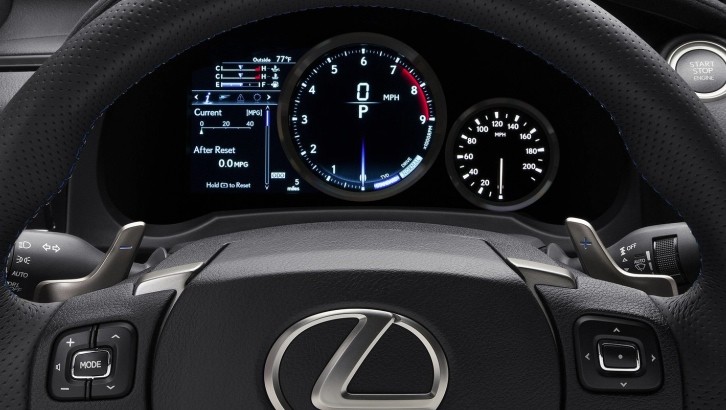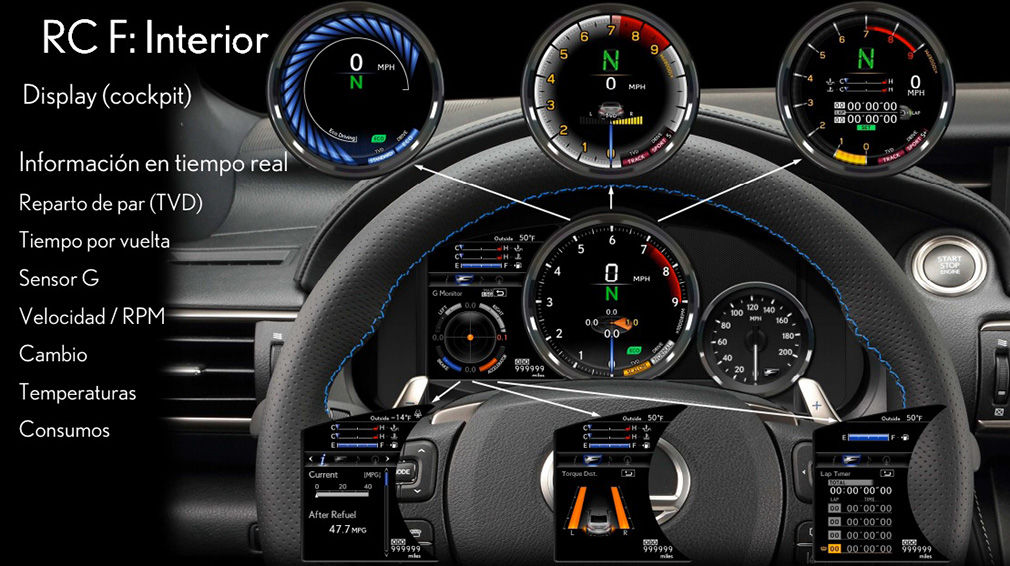When we saw the LFA-inspired instrument cluster on the 2014 Lexus IS F Sport we thought things can’t get better than that. It was so simple yet so interesting to look at and the way it was moving sideways to reveal additional info took our minds straight into Need For Speed territory. But then we saw the one fitted on the new RC F performance coupe.
What’s interesting about it? Well, it’s still based on what we saw on the LFA, but it comes in a better setup. You see, if starting to look at it from right to left you can spot an evolution of the automotive instrumentation.
The first one is the speedometer, which is the classic analogue simple dial we know from the beginning of the auto industry - a simple chromed ring with a central rotating needle and printed numbers on the side of the ring. It’s there, its simple to read and, as in most cases with today sportscars, it has been left to the side because when you’re racing, speed is not exactly what you monitor all the time.
Next comes the center dial which displays the revs and current gear. This one represents the next evolutionary phase of vehicles’ gauges. It still has a physical metal ring to contain all the information but everything you see here is digital - the needle, markings, numbers and other info is coming through a high-resolution LCD display. This allows you to customize what you see and as the photo here depicts, the RC F’s central gauge will feature around four themes, changing according to the driving mode you select. It will also be able to show you the exact moment to upshift and even keep track of your progress.
The left part of the dash instrumentation is the current step in the dials evolution - everything digital. No physical rings or needles whatsoever, here is just a highly responsive high-res digital display able to show you a lot of secondary parameters regarding the vehicle’s condition and your actions. Such as fluid temperatures, fuel level, fuel consumption, a real-time torque distribution diagram and even lap times.
And this is exactly what an instrument panel should be now - an engineering gem combining the best out of the two world - digital and analogue - while everything should look crispy clear and move as fluid as possible, all arranged using an easy to read minimalist design.
Our only hope is that Lexus will implement this technology into its infotainment system. We all know how boring, outdated and laggy those systems are.
Also, check the video bellow for a demonstration of how the RC F’s dashboard works on a simulator.
The first one is the speedometer, which is the classic analogue simple dial we know from the beginning of the auto industry - a simple chromed ring with a central rotating needle and printed numbers on the side of the ring. It’s there, its simple to read and, as in most cases with today sportscars, it has been left to the side because when you’re racing, speed is not exactly what you monitor all the time.
Next comes the center dial which displays the revs and current gear. This one represents the next evolutionary phase of vehicles’ gauges. It still has a physical metal ring to contain all the information but everything you see here is digital - the needle, markings, numbers and other info is coming through a high-resolution LCD display. This allows you to customize what you see and as the photo here depicts, the RC F’s central gauge will feature around four themes, changing according to the driving mode you select. It will also be able to show you the exact moment to upshift and even keep track of your progress.
The left part of the dash instrumentation is the current step in the dials evolution - everything digital. No physical rings or needles whatsoever, here is just a highly responsive high-res digital display able to show you a lot of secondary parameters regarding the vehicle’s condition and your actions. Such as fluid temperatures, fuel level, fuel consumption, a real-time torque distribution diagram and even lap times.
And this is exactly what an instrument panel should be now - an engineering gem combining the best out of the two world - digital and analogue - while everything should look crispy clear and move as fluid as possible, all arranged using an easy to read minimalist design.
Our only hope is that Lexus will implement this technology into its infotainment system. We all know how boring, outdated and laggy those systems are.
Also, check the video bellow for a demonstration of how the RC F’s dashboard works on a simulator.


